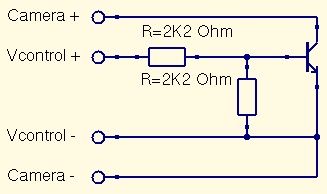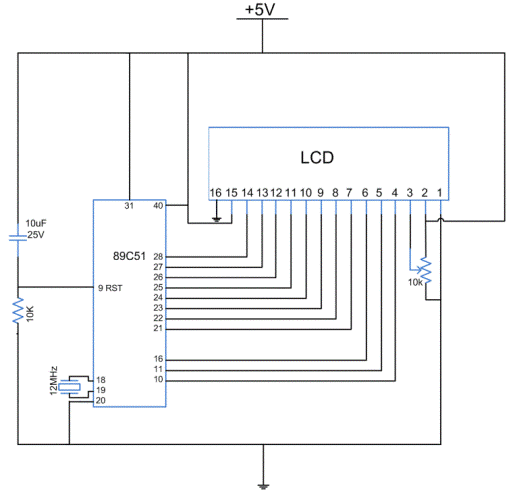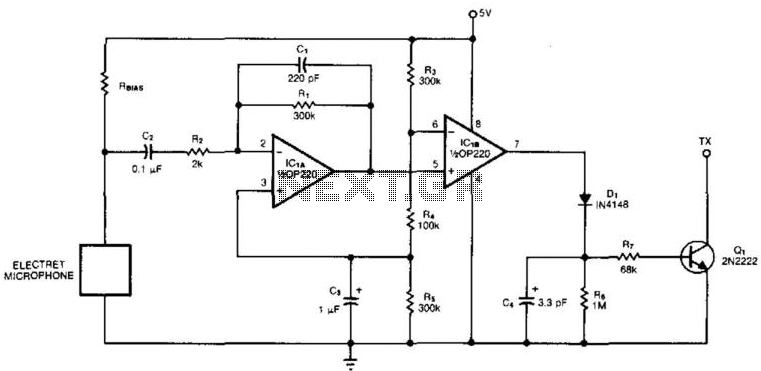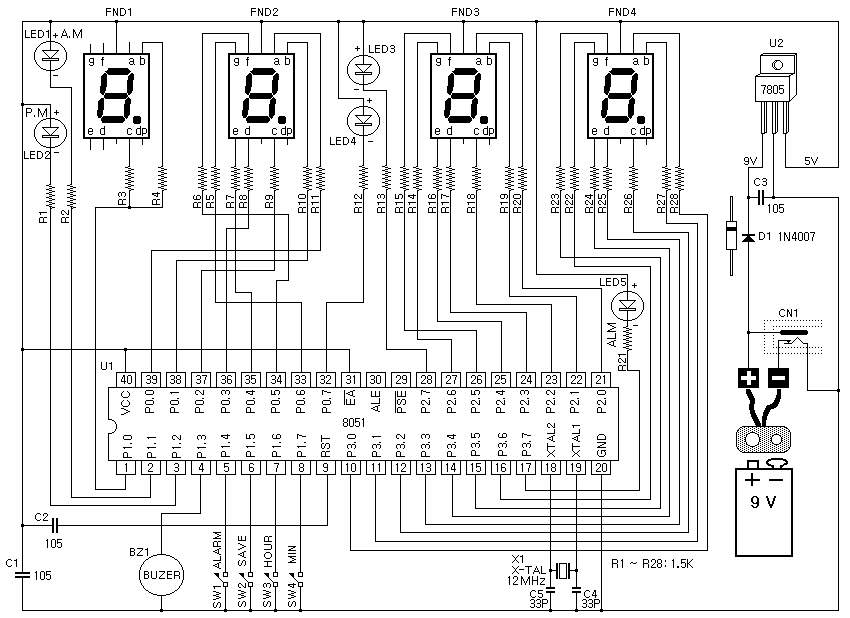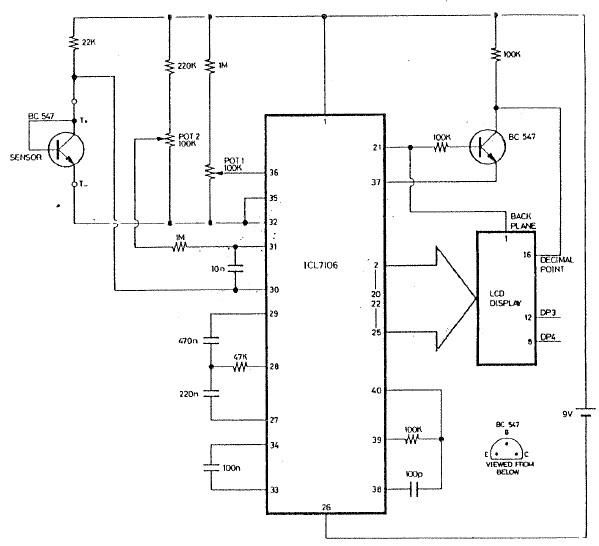
Digital thermometer with LED / LCD display
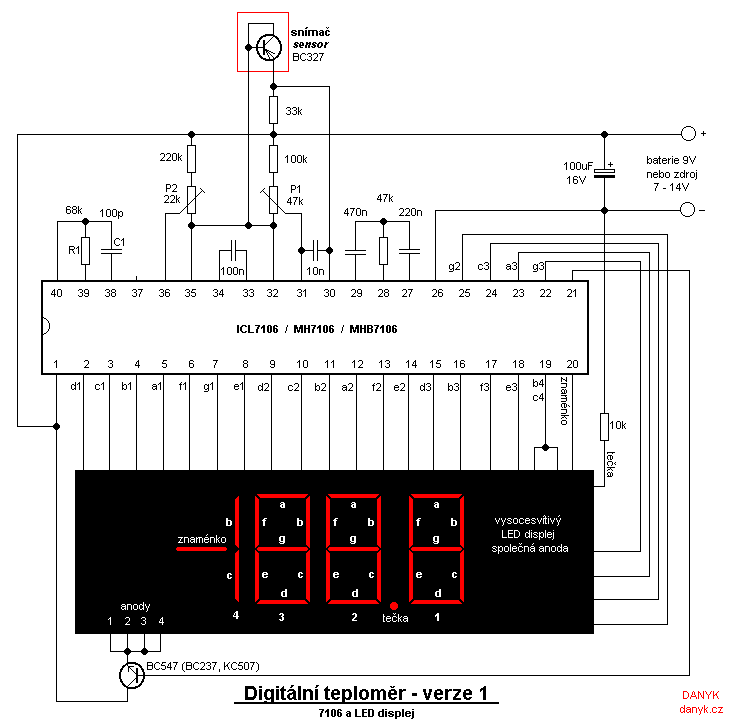
Two versions of a homemade digital thermometer utilizing the ICL7106 are presented. One version features an LED display, while the other employs an LCD display. Both variants utilize a silicon transistor as a temperature sensor, with temperature determined by the voltage drop, which has a temperature dependence of approximately -2.2 mV/°C. Power can be supplied by either a 9V battery or an appropriate power supply. The oscillator, composed of resistor R1 and capacitor C1, sets the sampling frequency; using values of 100kΩ and 100pF results in a frequency of 3 Hz. The theoretical temperature range spans from -199.9°C to 199.9°C, although the actual measuring range is limited by the characteristics of the measuring transistor to approximately -65.0°C to 150.0°C, with a resolution of 0.1°C. For room temperature measurement, the hundreds digit and the minus sign can be omitted, and if a resolution of 1°C is sufficient, the digit to the right of the decimal point may also be excluded, allowing for a simplified two-digit display. The LED version is typically constructed using the ICL7107, which offers a higher output current but necessitates a symmetrical stabilized power supply. In contrast, the ICL7106 allows for a simpler power supply without stabilization, addressing this issue with a low current (1 mA) superbright display. The ICL7106 is also easier to salvage from devices such as digital multimeters than the ICL7107. The ICL7106 circuit is connected in the standard manner. The LCD is driven by a 60Hz AC signal, with all outputs for the display and the common electrode terminal producing a rectangular 60Hz waveform. Outputs for segments not displayed maintain a voltage in phase with the common electrode, while outputs for segments that are displayed are out of phase. Transistor T1 serves as an inverter for the decimal point. An LCD thermometer may also be constructed by modifying an inexpensive or old digital multimeter, most of which utilize the ICL7106 or an equivalent circuit. The current consumption is less than 1 mA, making it suitable for battery operation. Calibration of the thermometer is necessary and is performed using trimmers P1 and P2 in two steps. The first step involves setting the zero point using crushed ice (a mixture of ice and water). P2 is initially set to approximately the center position. The probe (transistor) should be placed in a waterproof container and submerged in the crushed ice mixture. After stabilization, P1 is adjusted until the display reads 00.0°C. The second step involves adjusting P2 according to a known temperature, preferably boiling water at 100°C. Alternatively, P2 can be calibrated using another thermometer at room temperature. For precise adjustments, multiturn trimmers can be employed. Various thermometers can be utilized for this calibration process, although using different thermometers may result in reduced accuracy. Mercury laboratory thermometers are generally accurate, while inexpensive digital thermometers from Vietnam can be useful, and alcohol thermometers typically exhibit inaccuracies with a deviation of about 1°C.
The circuit design of the homemade digital thermometer with ICL7106 involves several key components and configurations that ensure accurate temperature measurement and display. The silicon transistor, acting as the temperature sensor, is central to the operation, converting temperature variations into corresponding voltage changes. The voltage drop across the transistor is directly proportional to the temperature, which is critical for the thermometer's functionality.
The choice of power supply is flexible, allowing for either a 9V battery or an external power source, which enhances the versatility of the device. The oscillator circuit, consisting of R1 and C1, is fundamental in determining the sampling rate of the temperature measurements. The frequency of 3 Hz, established by the selected resistor and capacitor values, ensures that the thermometer provides timely updates of the temperature reading.
The display technology varies between the two versions, with the LED display being more power-intensive and requiring a stabilized power supply, whereas the LCD version benefits from lower power consumption and simpler power requirements. The use of a superbright display in the ICL7106 version allows for clear visibility while maintaining low current draw, making it ideal for portable applications.
Calibration is a critical aspect of the thermometer's design, ensuring that the readings are accurate across the specified temperature range. The two-step calibration process using trimmers allows for fine-tuning of the device, accommodating variations in the temperature sensor's characteristics and ensuring reliable performance.
In summary, this homemade digital thermometer design effectively combines simplicity with functionality, providing an accessible means for temperature measurement that can be adapted for various applications, including room temperature monitoring and other uses where accurate temperature readings are essential.Now we bring you two versions of a homemade digital thermometer with ICL7106 that I recently built. One version uses a LED display, the second version LCD display. In both versions, is used silicon transistor as a temperature sensor. The temperature is determined by the voltage drop, temperature dependence is approximately -2. 2 mV / °C. Power can be either a 9V battery or a suitable power supply. Oscillator with R1 and C1 determines the sampling frequency - using 100k and 100p the frequency is 3 Hz. Theoretical temperature range is from -199. 9 to 199. 9 °C, the real temperature range is limited by the measuring transistor to approximately -65. 0 To 150. 0 °C. Resolution to 0. 1 °C. If you want to use it as a room thermometer, it is not necessary to use the hundreds digit, (left) or minus sign.
Also digit right from the decimal point may be omitted if 1 °C resolution is sufficient. A simple room thermometer thus requires only two-digit display, as on photo below. LED version is usually constructed with the circuit ICL7107, which has a higher output current, but this circuit requires symmetrical stabilized power supply. Advantage of 7106 is a simple power supply without stabilization. The problem is solved by a low curren (1 mA) superbright display. 7106 is also easier to salvage from something (like digital multimetr) than 7107. I will not discuss the 7107 here. Info on both those integrated circuits can be found in their datasheet. Here, the circuit 7106 is connected in the usual way. LCD is driven by AC 60Hz signal. At all outputs for display and the common electrode terminal have a rectangle 60Hz waveform. Outputs for the segments that are not to be displayed, have a voltage in phase with a common electrode.
Outputs for segments that are displayed, are out of phase. T1 is used as an inverter for the decimal point. Thermometer with LCD is also possible to make by rebuilding cheap or old digital multimeter (most of them used circuit ICL7106 or some equivalent. 7106). Current consumption is less than 1 mA, therefore it is suitable for battery power. The thermometer must be calibrated. Calibration is performed using the trimmer P1 and P2 in two steps. The first step is to set the zero using crushed ice (the ice and water mix). Set P2 approximately in the center. Probe (Transistor) Place in a waterproof container and dip into crushed ice (ice pieces in water). After stabilizing the set P1 and to display 00. 0 °C. In the second step P2 is set according to a known temperature, preferably in boiling water at 100 °C.
Alternatively the P2 setting can be made according to another thermometer at room temperature. For accurate setting you can use multiturn trimmers. Various thermometers. To calibrate P2 they also can be used (to avoid working with boiling water) but the accuracy is worse. Mercury laboratory thermometers are fairly accurate, cheap digital thermometers from Vietnamese still usefull, alcohol thermometers are inaccurate (deviation commonly about 1 °C).
🔗 External reference
The circuit design of the homemade digital thermometer with ICL7106 involves several key components and configurations that ensure accurate temperature measurement and display. The silicon transistor, acting as the temperature sensor, is central to the operation, converting temperature variations into corresponding voltage changes. The voltage drop across the transistor is directly proportional to the temperature, which is critical for the thermometer's functionality.
The choice of power supply is flexible, allowing for either a 9V battery or an external power source, which enhances the versatility of the device. The oscillator circuit, consisting of R1 and C1, is fundamental in determining the sampling rate of the temperature measurements. The frequency of 3 Hz, established by the selected resistor and capacitor values, ensures that the thermometer provides timely updates of the temperature reading.
The display technology varies between the two versions, with the LED display being more power-intensive and requiring a stabilized power supply, whereas the LCD version benefits from lower power consumption and simpler power requirements. The use of a superbright display in the ICL7106 version allows for clear visibility while maintaining low current draw, making it ideal for portable applications.
Calibration is a critical aspect of the thermometer's design, ensuring that the readings are accurate across the specified temperature range. The two-step calibration process using trimmers allows for fine-tuning of the device, accommodating variations in the temperature sensor's characteristics and ensuring reliable performance.
In summary, this homemade digital thermometer design effectively combines simplicity with functionality, providing an accessible means for temperature measurement that can be adapted for various applications, including room temperature monitoring and other uses where accurate temperature readings are essential.Now we bring you two versions of a homemade digital thermometer with ICL7106 that I recently built. One version uses a LED display, the second version LCD display. In both versions, is used silicon transistor as a temperature sensor. The temperature is determined by the voltage drop, temperature dependence is approximately -2. 2 mV / °C. Power can be either a 9V battery or a suitable power supply. Oscillator with R1 and C1 determines the sampling frequency - using 100k and 100p the frequency is 3 Hz. Theoretical temperature range is from -199. 9 to 199. 9 °C, the real temperature range is limited by the measuring transistor to approximately -65. 0 To 150. 0 °C. Resolution to 0. 1 °C. If you want to use it as a room thermometer, it is not necessary to use the hundreds digit, (left) or minus sign.
Also digit right from the decimal point may be omitted if 1 °C resolution is sufficient. A simple room thermometer thus requires only two-digit display, as on photo below. LED version is usually constructed with the circuit ICL7107, which has a higher output current, but this circuit requires symmetrical stabilized power supply. Advantage of 7106 is a simple power supply without stabilization. The problem is solved by a low curren (1 mA) superbright display. 7106 is also easier to salvage from something (like digital multimetr) than 7107. I will not discuss the 7107 here. Info on both those integrated circuits can be found in their datasheet. Here, the circuit 7106 is connected in the usual way. LCD is driven by AC 60Hz signal. At all outputs for display and the common electrode terminal have a rectangle 60Hz waveform. Outputs for the segments that are not to be displayed, have a voltage in phase with a common electrode.
Outputs for segments that are displayed, are out of phase. T1 is used as an inverter for the decimal point. Thermometer with LCD is also possible to make by rebuilding cheap or old digital multimeter (most of them used circuit ICL7106 or some equivalent. 7106). Current consumption is less than 1 mA, therefore it is suitable for battery power. The thermometer must be calibrated. Calibration is performed using the trimmer P1 and P2 in two steps. The first step is to set the zero using crushed ice (the ice and water mix). Set P2 approximately in the center. Probe (Transistor) Place in a waterproof container and dip into crushed ice (ice pieces in water). After stabilizing the set P1 and to display 00. 0 °C. In the second step P2 is set according to a known temperature, preferably in boiling water at 100 °C.
Alternatively the P2 setting can be made according to another thermometer at room temperature. For accurate setting you can use multiturn trimmers. Various thermometers. To calibrate P2 they also can be used (to avoid working with boiling water) but the accuracy is worse. Mercury laboratory thermometers are fairly accurate, cheap digital thermometers from Vietnamese still usefull, alcohol thermometers are inaccurate (deviation commonly about 1 °C).
🔗 External reference
Warning: include(partials/cookie-banner.php): Failed to open stream: Permission denied in /var/www/html/nextgr/view-circuit.php on line 713
Warning: include(): Failed opening 'partials/cookie-banner.php' for inclusion (include_path='.:/usr/share/php') in /var/www/html/nextgr/view-circuit.php on line 713
